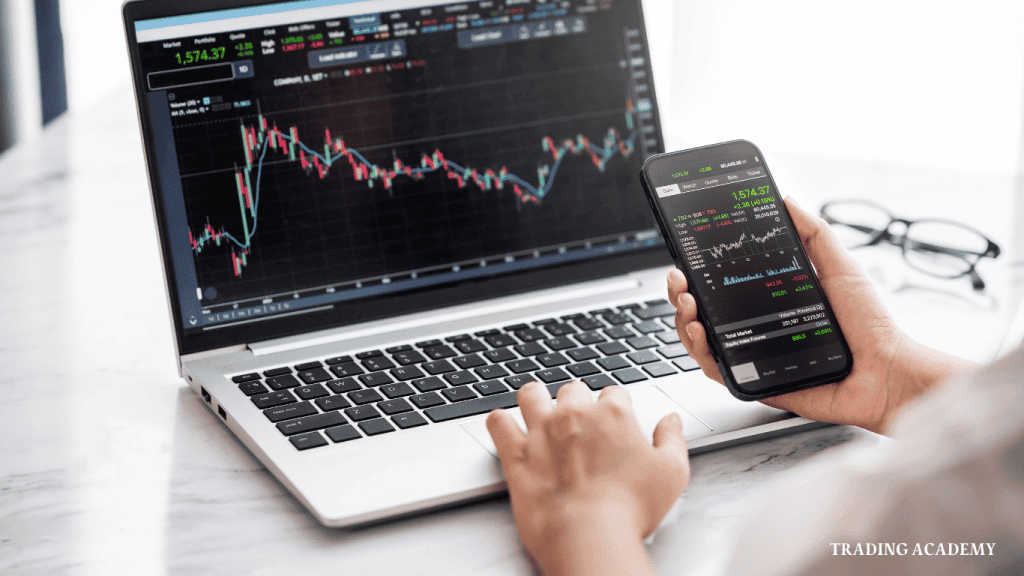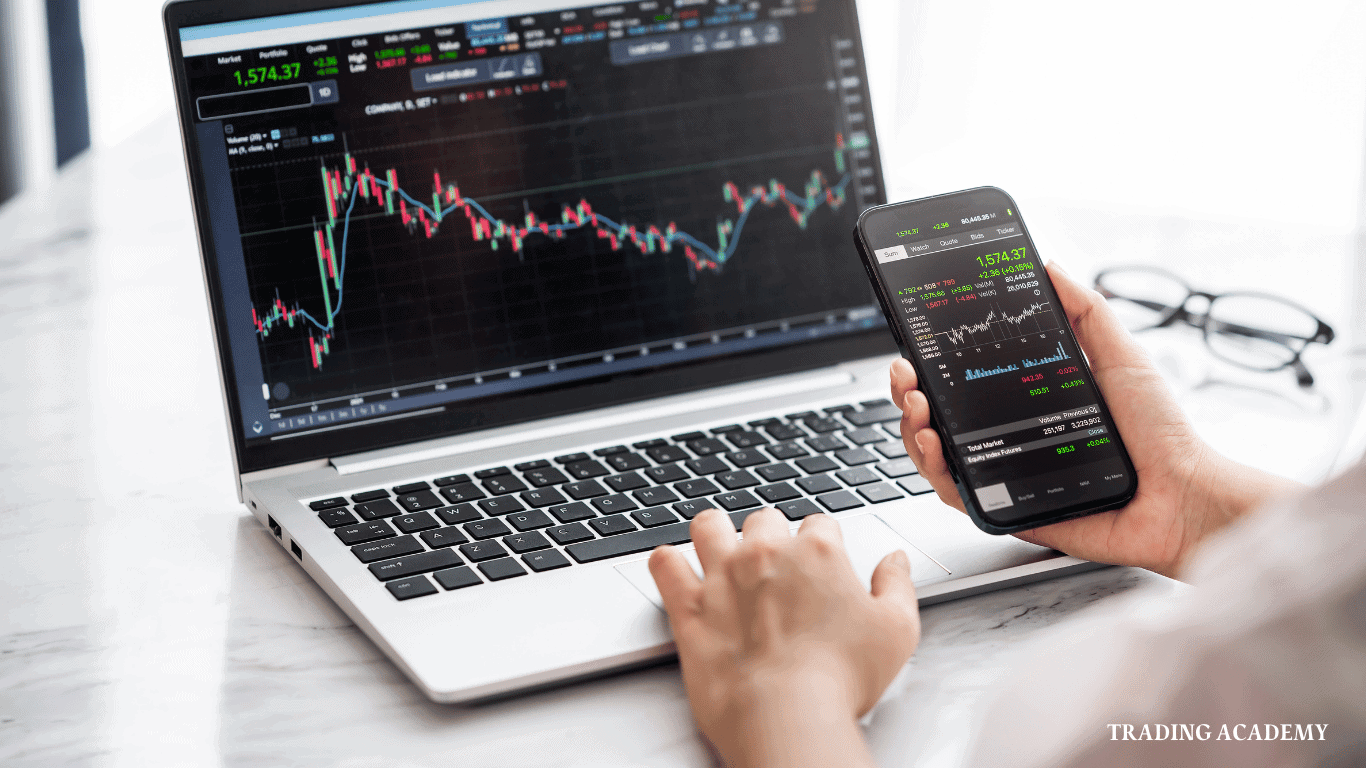
Are you completely new to trading and looking for a beginner-friendly course to help you get started?
If you’re wondering, “How do I trade forex?” or “How does trading work?” then this article is perfect for you.
In this article, we provide a clear definition of trading, cover the basics to help you start learning, explain key trading terminology, and guide you on where to find beginner trading courses.
What is trading?
Let’s begin with the basics: What exactly is trading?
Trading is an activity that takes place in financial markets through your online trading platform, allowing you to place buy and sell orders on various products such as forex, stock indices, ETFs, and CFDs (Contracts for Difference). The goal for a trader is to buy or sell a financial instrument at a specific price in order to make a profit. However, it’s important to note that trading can also lead to financial losses.
Indeed, if you buy the EUR/USD currency pair (euro against the U.S. dollar) and its value drops, you will see your capital decrease.
Trading also means having access to financial market quotes through a user-friendly platform. This platform allows you to:
- Open a trading account
- Analyze the asset of your choice
- Buy at the best price if you believe the price will rise
- Sell at the best price if you believe the price will fall
The Basics of Learning Trading : Forex, Stock indices, ETFs and CFDs for Beginners
The basics of trading are essential to understand when starting out. You need to be familiar with the different financial assets, basic terminology, how to use a trading platform, and the various strategies available. These elements will help ensure you aren’t overwhelmed when you begin trading.
Before starting trading, it’s important to have a solid understanding of the basics. This foundation will help you make informed decisions and navigate the markets with more confidence.
Carefully read the following information and take some notes to learn how to trade online for free.
Trading Financial Products
In financial markets, you can trade a variety of instruments, including:
- Currencies
- Index CFDs
- Stock CFDs
- ETF CFDs
- Cryptocurrency CFDs
- Commodity CFDs
- Bond CFDs
Currencies
Forex trading involves the exchange of currencies such as the U.S. Dollar (USD), Euro (EUR), Japanese Yen (JPY), and many others. These currencies are traded in pairs on the Forex market, with the most commonly traded pairs including:
- EUR/USD: Euro against the U.S. Dollar
- GBP/USD: British Pound against the U.S. Dollar
- USD/JPY: U.S. Dollar against the Japanese Yen
- EUR/JPY: Euro against the Japanese Yen
- USD/CHF: U.S. Dollar against the Swiss Franc
- USD/CAD: U.S. Dollar against the Canadian Dollar
- AUD/USD: Australian Dollar against the U.S. Dollar
CFDs for Beginners
If you’re reading this article, you likely have some knowledge of the stock market, such as the CAC 40, the Paris Stock Exchange index. When investing in the CAC 40, you might buy shares in a company listed in the index, such as FDJ stock.
The downside of buying a stock is that you can only profit if its value increases. If you expect the price to fall, you would have to wait for a trend reversal.
CFDs (Contracts for Difference) offer a way to benefit from both the rise and fall of a stock. This allows traders to speculate on price movements without owning the underlying asset.
What is a CFD?
CFD Trading for Beginners
A CFD (Contract for Difference) is a financial product that allows you to trade on both rising and falling prices of an underlying asset, such as a stock, bond, index, cryptocurrency, or commodity, without actually owning the asset. This means you can speculate on price movements without taking ownership.
One key advantage of CFDs is the ability to profit from the decline in an asset’s value by “shorting” it.
For example, if you believe the price of FDJ stock will drop, instead of waiting for the price to recover, you can short the FDJ CFD, allowing you to trade on the asset’s price decrease.
Important Note: CFDs often involve leverage, which means you can control a larger position with a smaller amount of capital. However, this also increases the risk of significant losses. Always be mindful of the risks and avoid trading with money you can’t afford to lose.
Your broker will typically offer CFDs on various markets, including indices (CAC 40, DAX, Dow Jones), stocks, commodities, cryptocurrencies, ETFs, and even bonds. For a complete list of CFDs available at Admirals, visit their Contract Specifications page.
Day Trading for Beginners
As the name suggests, day trading is limited to a single trading day, meaning all trades must be closed by the end of the day.
For example, a day trader might take 3 positions in a day, aiming for profits of 15 to 50 pips per trade. In this strategy, Japanese candlestick charts with time frames from 1 minute (M1) to 15 minutes (M15) are often used to analyze price movements.
Day trading allows traders to control the number of positions they open and close within the day.
For a day trader, it’s crucial to monitor the economic calendar and avoid holding positions when major news or announcements are expected, as these can significantly impact the market.
Swing Trading Forex for Beginners
Swing trading is ideal for traders who don’t have a lot of time to dedicate to daily market activities. However, it’s important to remember that trading is a serious commitment requiring long-term effort and focus.
A swing trader typically analyzes charts just a few minutes per week. But this doesn’t mean the trader only spends a few minutes trading. Swing traders need to stay informed about economic news and trends since their trades can remain open for several days.
Japanese candlestick charts with 4-hour (H4) or 1-hour (H1) time frames are used to refine positions. Staying up to date with current events is essential for swing traders, as trades left open for multiple days are more likely to be affected by market volatility due to major events.
Conclusion
As you’ve learned through this guide, trading is a serious endeavor, far from the quick-money schemes some may imagine. Success in trading requires dedication, consistent effort, and continuous learning. We hope this article has answered your questions and given you a clearer understanding of “how trading works.”
A trader’s mindset is also crucial; the ability to reflect on mistakes and adapt is essential for long-term success.
For this reason, we strongly recommend practicing with a demo account before moving to a live account. Additionally, take advantage of live sessions, webinars, and training courses to further enhance your skills.
Table of Contents :
What is trading?
The Basics of Learning Trading
Trading Financial Products
CFDs for Beginners
Day Trading for Beginners
Swing Trading Forex for Beginners



